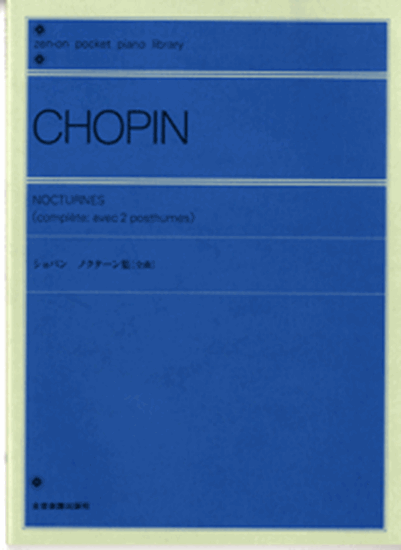Chopin, Frederic : Nocturne No.4 F-Dur Op.15-1
Work Overview
Genre:nocturne
Total Playing Time:3 min 30 sec
Copyright:Public Domain
Commentary (1)
Author : Hayashikawa, Takashi
Last Updated: January 31, 2019
[Open]
Author : Hayashikawa, Takashi
Three Nocturnes, Op. 15
Of these three nocturnes, No. 1 and No. 2 were composed in 1831 or 1832, and No. 3 in 1833. The scores were first published in Paris (M. Schlesinger, 1833), Leipzig (Breitkopf und Härtel, 1834), and London (Wessel, 1834). Ferdinand Hiller (1811-1885), a German pianist and composer to whom this work was dedicated, was one of Chopin's few trusted musicians and close friends, and they performed together in concerts. Although not widely known, Hiller's name, alongside Liszt's, appears on the dedication page of the first English edition of Chopin's Études, Op. 10, indicating his particular importance among Chopin's circle in the 1830s.
Nocturne Op.15 No.1
This nocturne is written in the common ternary form (A-B-B'-A') found in Chopin's nocturnes. A and A' are almost identical, except that the latter features increased ornamentation and a short coda. Although B and B' differ in their development, their first four measures are exactly the same, and a symmetrical structure is evident in their 12-measure length and the fact that the final measure is in 6/8 time. Such a strict symmetrical structure is not found elsewhere in Chopin's nocturnes.
In the A section, a simple, unadorned melody is sung over a triplet accompaniment in the left hand. The tempo marking 'Andante cantabile' combined with the expression 'semplice e tranquillo' likely means that, even though it is to be sung, it should be performed without exaggerated vocal inflections. These performance indications offer a glimpse into Chopin's aesthetic, which disliked the grandiloquent vocalizations typical of Meyerbeer's grand operas. In measure 22, just when the phrase seems to conclude, the opening theme reappears and begins to sing again, but after three measures, the song 'fades away' with the instruction 'smorzando,' losing strength and being interrupted (Musical Example 1).
Musical Example 1: Measures 21-24, end of A section
In the middle section (B, B'), marked 'con fuoco' (with fire), the right hand plays a chordal accompaniment while the left hand carries a wave-like melody, whose amplitude gradually increases (in the first two measures, its range is two octaves; in the next two measures, it expands to two octaves and a fifth). In contrast to the A section, where only 'p' was used for dynamics and the melody progressed calmly, the B section begins with 'f,' and the main motif in the left hand is marked with crescendo and accent signs, creating an extreme contrast with the main section. No other Chopin nocturne exhibits such a strong stylistic contrast.
Musical Example 2: Measures 25-26, beginning of B section
These right-hand chords are a technique rarely seen in Chopin's works, rather approaching Kalkbrenner's writing style of the 1830s. Chopin himself wrote simplified figures into the scores of his pupil J. Sterling (see commentary on Op. 55). A' is largely a recapitulation of A. Similar to A, in measure 70, just when the phrase seems to conclude, the opening theme appears and leads into a brief five-measure coda. Here, 'pp' is seen, which was not present the first time, yet the three indications 'diminuendo,' 'rallentando,' and 'smorzando' are emphatically written. The piece ends with a decrease in both tempo and volume, concluding with two arpeggiated chords, almost fading away. (Takashi Hayashikawa)
Sheet Music
Scores List (12)

(株)全音楽譜出版社

ハンナ(ショパン)

(株)ドレミ楽譜出版社

(株)音楽之友社

(株)全音楽譜出版社

(株)音楽之友社

(株)全音楽譜出版社

(株)全音楽譜出版社

(株)全音楽譜出版社

ポーランド音楽出版社

(株)ヤマハミュージックエンタテインメントホールディングス

(株)音楽之友社

